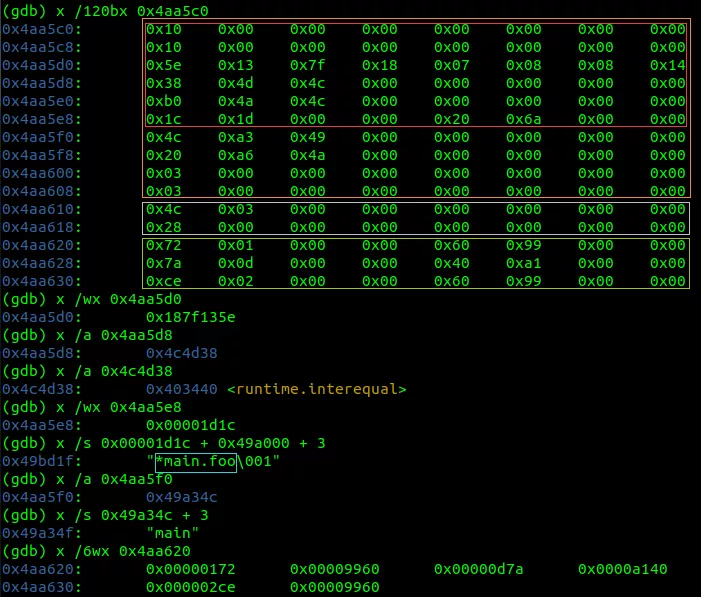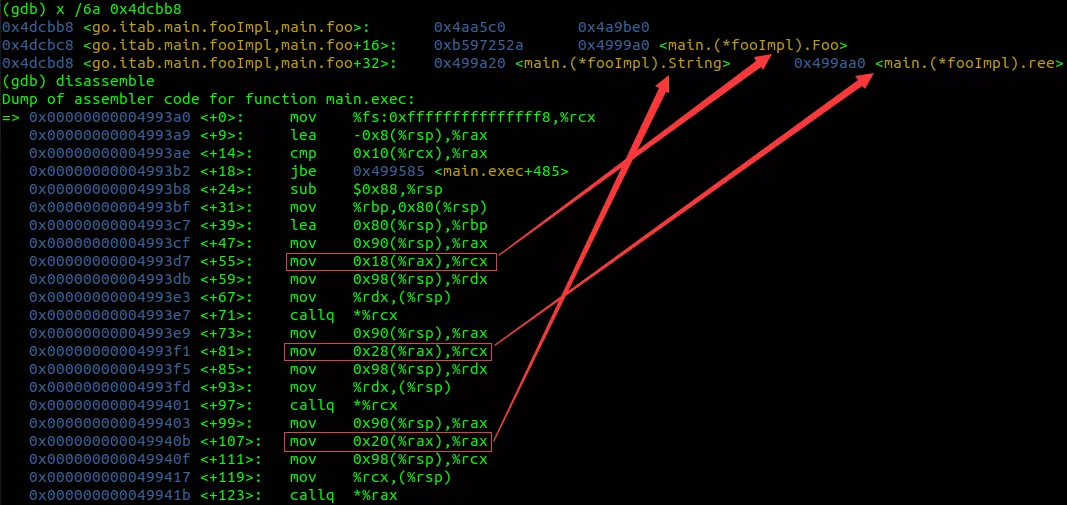前言
抽象来讲,接口,是一种约定,是一种约束,是一种协议。
在Go语言中,接口是一种语法类型,用来定义一种编程规范。
在Go语言中,接口主要有两类:
没有方法定义的空接口
有方法定义的非空接口
之前,有两篇图文详细介绍了空接口对象及其类型:
- 【Go】内存中的空接口
- 【Go】再谈空接口
本文将深入探究包含方法的非空接口,以下简称接口。
环境
OS : Ubuntu 20.04.2 LTS; x86_64
Go : go version go1.16.2 linux/amd64
- 1.
- 2.
声明
操作系统、处理器架构、Go版本不同,均有可能造成相同的源码编译后运行时的寄存器值、内存地址、数据结构等存在差异。
本文仅包含 64 位系统架构下的 64 位可执行程序的研究分析。
本文仅保证学习过程中的分析数据在当前环境下的准确有效性。
代码清单
// interface_in_memory.go
package main
import "fmt"
import "reflect"
import "strconv"
type foo interface {
fmt.Stringer
Foo()
ree()
}
type fooImpl int
//go:noinline
func (i fooImpl) Foo() {
println("hello foo")
}
//go:noinline
func (i fooImpl) ree() {
println("hello ree")
}
//go:noinline
func (i fooImpl) String() string {
return strconv.Itoa(int(i))
}
func main() {
impl := fooImpl(123)
impl.Foo()
impl.ree()
fmt.Println(impl.String())
typeOf(impl)
exec(impl)
}
//go:noinline
func exec(foo foo) {
foo.Foo()
foo.ree()
fmt.Println(foo.String())
typeOf(foo)
fmt.Printf("exec 参数类型地址:%p\n", reflect.TypeOf(exec).In(0))
}
//go:noinline
func typeOf(i interface{}) {
v := reflect.ValueOf(i)
t := v.Type()
fmt.Printf("类型:%s\n", t.String())
fmt.Printf("地址:%p\n", t)
fmt.Printf("值 :%d\n", v.Int())
fmt.Println()
}
- 1.
- 2.
- 3.
- 4.
- 5.
- 6.
- 7.
- 8.
- 9.
- 10.
- 11.
- 12.
- 13.
- 14.
- 15.
- 16.
- 17.
- 18.
- 19.
- 20.
- 21.
- 22.
- 23.
- 24.
- 25.
- 26.
- 27.
- 28.
- 29.
- 30.
- 31.
- 32.
- 33.
- 34.
- 35.
- 36.
- 37.
- 38.
- 39.
- 40.
- 41.
- 42.
- 43.
- 44.
- 45.
- 46.
- 47.
- 48.
- 49.
- 50.
- 51.
- 52.
- 53.
- 54.
- 55.
- 56.
- 57.
以上代码,定义了一个包含3个方法的接口类型foo,还定义了一个fooImpl类型。在语法上,我们称fooImpl类型实现了foo接口。
运行结果
程序结构
数据结构介绍
接口数据类型的结构定义在reflect/type.go源文件中,如下所示:
// 表示一个接口方法
type imethod struct {
name nameOff // 方法名称相对程序 .rodata 节的偏移量
typ typeOff // 方法类型相对程序 .rodata 节的偏移量
}
// 表示一个接口数据类型
type interfaceType struct {
rtype // 基础信息
pkgPath name // 包路径信息
methods []imethod // 接口方法
}
- 1.
- 2.
- 3.
- 4.
- 5.
- 6.
- 7.
- 8.
- 9.
- 10.
- 11.
- 12.
其实这只是一个表象,完整的接口数据类型结构如下伪代码所示:
// 表示一个接口类型
type interfaceType struct {
rtype // 基础信息
pkgPath name // 包路径信息
methods []imethod // 接口方法的 slice,实际指向 array 字段
u uncommonType // 占位
array [len(methods)]imethod // 实际的接口方法数据
}
- 1.
- 2.
- 3.
- 4.
- 5.
- 6.
- 7.
- 8.
完整的结构分布图如下:
另外两个需要了解的结构体,之前文章已经多次介绍过,也在reflect/type.go源文件中,定义如下:
type uncommonType struct {
pkgPath nameOff // 包路径名称偏移量
mcount uint16 // 方法的数量
xcount uint16 // 公共导出方法的数量
moff uint32 // [mcount]method 相对本对象起始地址的偏移量
_ uint32 // unused
}
- 1.
- 2.
- 3.
- 4.
- 5.
- 6.
- 7.
reflect.uncommonType结构体用于描述一个数据类型的包名和方法信息。对于接口类型,意义不是很大。
// 非接口类型的方法
type method struct {
name nameOff // 方法名称偏移量
mtyp typeOff // 方法类型偏移量
ifn textOff // 通过接口调用时的地址偏移量;接口类型本文不介绍
tfn textOff // 直接类型调用时的地址偏移量
}
- 1.
- 2.
- 3.
- 4.
- 5.
- 6.
- 7.
reflect.method结构体用于描述一个非接口类型的方法,它是一个压缩格式的结构,每个字段的值都是一个相对偏移量。
type nameOff int32 // offset to a name
type typeOff int32 // offset to an *rtype
type textOff int32 // offset from top of text section
- 1.
- 2.
- 3.
- nameOff 是相对程序 .rodata 节起始地址的偏移量。
- typeOff 是相对程序 .rodata 节起始地址的偏移量。
- textOff 是相对程序 .text 节起始地址的偏移量。
接口实现类型
从以上“运行结果”可以看到,fooImpl的类型信息位于0x4a9be0内存地址处。
关于fooImpl类型,【Go】再谈整数类型一文曾进行过非常详细的介绍,此处仅分析其方法相关内容。
查看fooImpl类型的内存数据如下:
绘制成图表如下:
fooImpl类型有3个方法,我们以Foo方法来说明接口相关的底层原理。
Foo方法的相关数据如下:
var Foo = reflect.method {
name: 0x00000172, // 方法名称相对程序 `.rodata` 节起始地址的偏移量
mtyp: 0x00009960, // 方法类型相对程序 `.rodata` 节起始地址的偏移量
ifn: 0x000989a0, // 接口调用的指令相对程序 `.text` 节起始地址的偏移量
tfn: 0x00098160, // 正常调用的指令相对程序 `.text` 节起始地址的偏移量
}
- 1.
- 2.
- 3.
- 4.
- 5.
- 6.
方法名称
method.name用于定位方法的名称,即一个reflect.name对象。
Foo方法的reflect.name对象位于 0x49a172(0x00000172 + 0x49a000)地址处,毫无疑问,解析结果是Foo。
(gdb) p /x 0x00000172 + 0x49a000
$3 = 0x49a172
(gdb) x /3bd 0x49a172
0x49a172: 1 0 3
(gdb) x /3c 0x49a172 + 3
0x49a175: 70 'F' 111 'o' 111 'o'
(gdb)
- 1.
- 2.
- 3.
- 4.
- 5.
- 6.
- 7.
方法类型
method.mtyp用于定位方法的数据类型,即一个reflect.funcType对象。
Foo方法的reflect.funcType对象,其位于0x4a3960(0x00009960 + 0x49a000)地址处。
Foo方法的数据类型的字符串表示形式是func()。
(gdb) x /56bx 0x4a3960
0x4a3960: 0x08 0x00 0x00 0x00 0x00 0x00 0x00 0x00
0x4a3968: 0x08 0x00 0x00 0x00 0x00 0x00 0x00 0x00
0x4a3970: 0xf6 0xbc 0x82 0xf6 0x02 0x08 0x08 0x33
0x4a3978: 0x00 0x00 0x00 0x00 0x00 0x00 0x00 0x00
0x4a3980: 0xa0 0x4a 0x4c 0x00 0x00 0x00 0x00 0x00
0x4a3988: 0x34 0x11 0x00 0x00 0x00 0x00 0x00 0x00
0x4a3990: 0x00 0x00 0x00 0x00 0x00 0x00 0x00 0x00
(gdb) x /wx 0x4a3988
0x4a3988: 0x00001134
(gdb) x /s 0x00001134 + 0x49a000 + 3
0x49b137: "*func()"
(gdb)
- 1.
- 2.
- 3.
- 4.
- 5.
- 6.
- 7.
- 8.
- 9.
- 10.
- 11.
- 12.
- 13.
想要深入了解函数类型,请阅读【Go】内存中的函数。
接口方法
method.ifn字段的英文注释为function used in interface call,即调用接口方法时使用的函数。
在本例中,就是通过foo接口调用fooImpl类型的Foo函数时需要执行的指令集合。
具体来讲就是,代码清单中的exec函数内调用Foo方法需要执行的指令集合。
Foo函数的method.ifn = 0x000989a0,计算出其指令集合位于地址0x4999a0(0x000989a0 + 0x401000)处。
通过内存数据可以清楚地看到,接口方法的符号是main.(*fooImpl).Foo。该函数主要做了两件事:
检查panic
在0x4999d7地址处调用另一个函数main.fooImpl.Foo。
类型方法
method.tfn字段的英文注释为function used for normal method call,即正常方法调用时使用的函数。
在本例中,就是通过fooImpl类型的对象调用Foo函数时需要执行的指令集合。
具体来讲就是,代码清单中的main函数内调用Foo方法需要执行的指令集合。
Foo函数的method.tfn = 0x00098160,计算出其指令集合位于地址0x499160(0x00098160 + 0x401000)处。
通过内存数据可以清楚地看到,类型方法的符号是main.fooImpl.Foo。
调用堆栈
通过上述分析,已经能够对method.ifn和method.tfn两个字段的含义建立起基本的认知。
实践是检验真理的唯一标准。能动手尽量别吵吵。
在main.(*fooImpl).Foo和main.fooImpl.Foo两个函数的入口处设置断点,通过行动巩固我们对接口类型的认识。
通过动态调试,我们清晰地看到:
- main函数调用了main.fooImpl.Foo函数
- exec函数调用了main.(*fooImpl).Foo函数
- main.(*fooImpl).Foo函数调用了main.fooImpl.Foo函数
- main.(*fooImpl).Foo函数的调试信息显示autogenerated,表示其是由编译器生成的
对比本文“代码清单”,你是否对Go语言的方法调用有了全新的认识。
几乎每种编程语言都会存在编译器自动生成代码的情况,用来实现某些通用逻辑的处理。本例中自动生成的main.(*fooImpl).Foo函数中增加了panic检查逻辑,不过, 乍看起来这像是某种设计缺陷导致不能直接调用main.fooImpl.Foo函数,而是必须经过一个"中间人"才行。
接口类型
从以上“运行结果”可以看到,exec函数的参数类型的地址是0x4aa5c0,也就是foo接口的类型信息存储位置。查看类型数据如下:
将以上内存数据绘制成图表如下:
- rtype.size = 16
- rtype.ptrdata = 16
- rtype.hash = 0x187f135e
- rtype.tflag = 0xf = reflect.tflagUncommon | reflect.tflagExtraStar | reflect.tflagNamed
- rtype.align = 8
- rtype.fieldAlign = 8
- rtype.kind = 0x14 = 20 = reflect.Interface
- rtype.equal = 0x4c4d38 -> runtime.interequal
- rtype.str = 0x000003e3 -> *main.foo
- rtype.ptrToThis = 0x00006a20 -> *foo
- interfaceType.pkgPath = 0x49a34c -> main
- interfaceType.methods.Data = 0x4aa620
- interfaceType.methods.Len = 3
- interfaceType.methods.Cap = 3
- uncommonType.pkgPath = 0x0000034c
- uncommonType.mcount = 0
- uncommonType.xcount = 0
- uncommonType.moff = 0x28
- interfaceType.methods[0].name = 0x00000172 -> Foo
- interfaceType.methods[0].typ = 0x00009960 -> func()
- interfaceType.methods[1].name = 0x00000d7a -> String
- interfaceType.methods[1].typ = 0x0000a140 -> func() string
- interfaceType.methods[2].name = 0x000002ce -> ree
- interfaceType.methods[2].typ = 0x00009960 -> func()
对象大小
接口类型的对象大小(rtype.size)是16字节,指针数据(rtype.ptrdata)占16字节;也就是说,接口类型的对象由2个指针组成,与空接口(interface{})对象大小一样。
比较函数
内存数据显示,接口类型的对象使用runtime.interequal进行相等性比较,该函数定义在runtime/alg.go源文件中:
func interequal(p, q unsafe.Pointer) bool {
x := *(*iface)(p)
y := *(*iface)(q)
return x.tab == y.tab && ifaceeq(x.tab, x.data, y.data)
}
func ifaceeq(tab *itab, x, y unsafe.Pointer) bool {
if tab == nil {
return true
}
t := tab._type
eq := t.equal
if eq == nil {
panic(errorString("comparing uncomparable type " + t.string()))
}
if isDirectIface(t) {
// See comment in efaceeq.
return x == y
}
return eq(x, y)
}
- 1.
- 2.
- 3.
- 4.
- 5.
- 6.
- 7.
- 8.
- 9.
- 10.
- 11.
- 12.
- 13.
- 14.
- 15.
- 16.
- 17.
- 18.
- 19.
- 20.
- 21.
该函数的执行逻辑是:
- 接口类型不同返回 false
- 接口类型为空返回 true
- 实现类型不可比较立即 panic
- 比较两个实现类型的对象并返回结果
uncommonType
在接口类型数据中,包路径信息可以通过interfaceType.pkgPath字段获取,方法信息通过interfaceType.methods字段获取, 因此uncommonType数据几乎没什么意义,只不过保持一致性罢了。
在本例中,可执行程序.rodata节的起始地址是0x49a000, interfaceType.pkgPath=uncommonType.pkgPath+0x49a000。
接口方法
接口方法(reflect.imethod)只有名称和类型信息,没有可执行指令,所以相对普通方法(reflect.method)缺少两个字段。
foo接口的方法的名称和类型,与fooImpl类型的方法的名称和类型完全一致,此处不再赘述。如有需要请阅读上文中方法相关的内容。
接口对象
runtime.interequal函数源码清晰地显示,其比较的是两个runtime.iface对象。
runtime.iface结构体定义在runtime/runtime2.go源码文件中,包含两个指针字段,大小是16个字节(rtype.size)。
type iface struct {
tab *itab
data unsafe.Pointer
}
type itab struct {
inter *interfacetype // 接口类型
_type *_type // 具体实现类型
hash uint32 // copy of _type.hash. Used for type switches.
_ [4]byte
fun [1]uintptr // variable sized. fun[0]==0 means _type does not implement inter.
}
- 1.
- 2.
- 3.
- 4.
- 5.
- 6.
- 7.
- 8.
- 9.
- 10.
- 11.
- 12.
该结构体与reflect/value.go源文件中定义的nonEmptyInterface结构体是等价的:
type nonEmptyInterface struct {
itab *struct {
ityp *rtype // 接口类型
typ *rtype // 具体实现类型
hash uint32 // 实现类型哈希种子
_ [4]byte // 内存对齐
fun [100000]unsafe.Pointer // 方法数组,编译器控制数组长度
}
word unsafe.Pointer // 具体实现类型对象
}
- 1.
- 2.
- 3.
- 4.
- 5.
- 6.
- 7.
- 8.
- 9.
- 10.
没错,接口对象就是iface对象,接口对象就是nonEmptyInterface对象。
源码清单中的exec函数接受一个foo接口类型的参数,在该函数入口处设置断点,即可查看其参数:
内存数据显示,exec函数的参数foo的值如下伪代码所示:
foo := runtime.iface {
tab: 0x4dcbb8,
data: 0x543ad8, // 指向整数 123
}
- 1.
- 2.
- 3.
- 4.
iface.data指针指向的内存数据是整数123,关于整数和runtime.staticuint64s,请阅读【Go】内存中的整数。
iface.tab指针指向一个全局符号go.itab.main.fooImpl,main.foo。该符号可以被视为一个全局常量,它是由Go编译器生成的,保存在可执行程序的.rodata节,其值如下伪代码所示:
go.itab.main.fooImpl,main.foo = & runtime.itab {
inter: 0x4aa5c0, // foo 接口类型的地址,上文已经详细分析
_type: 0x4a9be0, // fooImpl 实现类型的地址,上文已经详细分析
hash: 0xb597252a, // fooImpl 类型的哈希种子拷贝
fun: [0x4999a0, 0x499a20, 0x499aa0] // 方法数组
}
- 1.
- 2.
- 3.
- 4.
- 5.
- 6.
在本例中,runtime.iface.tab.fun字段值包含三个指针,分别指向以下三个函数:
- main.(*fooImpl).Foo (0x4999a0)
- main.(*fooImpl).String (0x499a20)
- main.(*fooImpl).ree (0x499aa0)
当exec函数调用foo接口的方法时,实际是从runtime.iface.tab.fun字段的数组中获得方法地址;
所以,在本例中,exec`函数只能寻址以上三个方法,而无法寻址以下三个方法:
- main.fooImpl.Foo
- main.fooImpl.String
- main.fooImpl.ree
如果定义新的类型实现了foo接口,作为参数传递给exec函数,Go编译器就会生成新的runtime.itab对象,并命名为go.itab.${pkg}.${type},main.foo格式,也是以相同的方式进行调用和执行。
在Go语言中,接口方法的调用逻辑是一致的。
接口扩展(继承)
在源码清单中,foo接口继承了fmt.Stringer接口,并扩展了两个方法。
type foo interface {
fmt.Stringer
Foo()
ree()
}
- 1.
- 2.
- 3.
- 4.
- 5.
而在程序运行时的内存数据中,在动态调试过程中,根本就没有fmt.Stringer接口什么事,连根毛都没看见。
实际上,Go编译器把foo接口的定义调整为以下代码,这就是接口继承和扩展的本质。
type foo interface {
String() string
Foo()
ree()
}
- 1.
- 2.
- 3.
- 4.
- 5.
总结
本文完整地、详细地、深入地剖析了Go语言接口的类型结构、对象结构、实现类型、方法调用、继承扩展等等的各个方面的底层原理。
相信这是对Go接口类型的一次重新认识。

















































